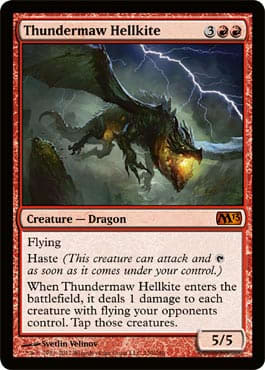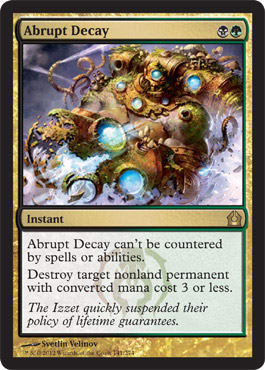Very few pure Draft formats exist in which someone won’t take a high-value rare when offered it. In a recent M13 draft, I cracked a foil Thundermaw Hellkite in pack one, took it, and heavily drafted blue and red. In the third pack, I opened Ajani, Caller of the Pride. Even without being in the color, I took him and didn’t blink. That was rare-drafting. We all do something like that from time to time, and we have stories of cards we opened or of card someone at the table saw.
I’ve published a few articles on how to rare-draft and win over the years, and they have invariably received a lot of heat because Draft purists, who draft frequently and who often don’t like rare-drafters. Rare-drafters mess up the signals they claim. Of course, the good news for them should be that rare-drafters often leave better cards behind for other decks in the packs, so they should be happy to sit downstream from a rare-drafter. If I draft Rest in Peace because it’s worth something on the market, and you are passed an Annihilating Fire because of it, I don’t see why that should upset you. Plus, there are numerous signals one is a rare-drafter, and you can see in just a couple of picks if that’s the case, so if you read the signals right, you’ll know.
I was a rare-drafter with a winning record in my Drafts despite rare-drafting constantly. My Limited rating on Magic Online tended to be in the low 1700s, achieved exclusively while rare-drafting. I knew what I was doing, and I shared it with the audience. Some took to that very unfavorably.
However, in the last few blocks, it has become impossible to go infinite while rare-drafting. I would draft and over time collect enough prizes and cards to make a profit. I would play in the 4–3–2–2 queue and just try to win that first game. Then, my expenditures to play in that tournament were around one pack and two tickets. It’s very easy to earn that back. When I’m receiving at least two packs roughly sixty percent of the time and making it to three packs quite often, it’s easy to turn rare-drafting into a gold mine of cards. But that stopped after WotC made some changes, which hurt one’s ability to rare-draft well and to win while doing it. Today, I want to discuss what those changes were and how they really hurt the art of rare-drafting the past few years.
Now, the fact that rare-drafting is no longer profitable over the long term does not mean that one can’t walk away from an individual Draft without making money from the cards selected. Also, there are still people who rare-draft because they need the cards or to add to their collections even though they will lose cash doing it. I am not referring to these two types of rare-drafting as dead. Instead, I am discussing the combination of dedicated rare-drafting with winning that I and several others practiced.
Let’s look at the changes:
The Number of Cards in a Pack
The first major change that WotC made to hurt rare-drafters was to yank a common from the packs for a basic land. Imagine a normal rare-draft and suppose that I make twelve choices based on the monetary value of the card rather than on its Draft value. These could be rares, mythics, high-value uncommons, and so forth. Now, if I am drafting from a pack that has fifteen cards to choose from, I am dropping from forty-five selections to thirty-three. When you drop a common in each pack, now I am seeing twenty-four fewer cards per Draft and taking three fewer cards. That’s a large drop off in late-round quality.
Where the rare-drafter lived was in picks four or five through the rest of the pack. This is where you had to really read the signals and take the best cards still there. This is where you grab creatures heavily. Even if my creatures are worse than yours, very few decks can handle an assault of twenty or twenty-one creatures in my deck, no matter how bad they are. You needed to see what powerful cards were undervalued in the Draft and collect them.
With three fewer cards, the number of cards that you have to make your deck shrinks significantly. Suppose no more than three or four of those twelve rare-drafted cards can be played in your deck. Now you have to find nineteen or twenty playable cards from thirty picks. Trying to build a deck that can win under these conditions is pretty tough (but fun!). There is no question that yanking a common from the packs hurt the ability to rare-draft successfully.
The Number of Rares in a Set and Mythics
The next thing WotC did was to pull the number of rares in a set and to introduce mythics. With one mythic every eight packs, that means in an average Draft, you’ll see three mythics opened. We all have stories of Drafts in which none were cracked or eight were. Several changes were made in the modern era at once, and all impacted rare-drafting.
One was actually good. A foil rare did not replace a rare, and the same was true with a foil uncommon. If I opened a pack with a foil uncommon or rare, that means we have an extra rare running around the circle. But even in a Draft with multiple foil rares opened (which almost never happens), that’s twenty- six rares and mythics rather than twenty-four. That’s a nice gain for rare-drafting, but it’s not enough of a bone to save it.
What really killed rare-drafting was the moving to mythics and the reduction in a set of the number of rares. Let’s look at why.
You will probably crack a mythic every eight packs, so let’s assume that you have just twenty-one rares opened at the table on average. Now we have massively reduced the number of rares that are in the set. So, when you open a pack, there are a lot more copies of whatever rare you select out there.
As supply increases, what happens to demand? It most cases, it drops. As demand drops, the prices also drop. Because there are fewer rares in print in the modern era, there are a lot more of each one running around. The three times a mythic is cracked at the table does not massively alter the number of rares opened, and therefore, your drafted rares are worth less money.
Just take a look at the value of rares from Shards of Alara versus Lorwyn. You will see that Lorwyn rares have a higher average value than the Shards rares. It’s no secret that the price of rares dropped significantly after the introduction of mythic rares. Just compare prices from Shards and later sets to earlier sets to see what I mean. With this loss in value, rare-drafting becomes impossible over the long term. Now when I draft a Standard set online, virtually all rares are assigned bulk value, whereas before, I could sell many rares for fifty cents or a full ticket; now those same quality rares earn me virtually nothing. Prices online are the same as in real life.
I think the introduction of mythics and the decrease of cards was good for Magic overall. I am still a proud card-carrying member of the DCI and a player of Magic. I haven’t stopped playing the game. But I am sad that the institution of rare-drafting and winning is dead. I long for the days when I could play four or five Drafts a week online and make tickets. I draft a lot less now because it doesn’t have that same verve.
Rare-drafting as a method to success has died. As I mentioned before, that does not mean that rare-drafting won’t happen to collect cards, for fun, or individually as we crack high-value cards, but the strategy of it and still winning is gone. Long may it live in my heart.
See you next week,
Abe Sargent

























